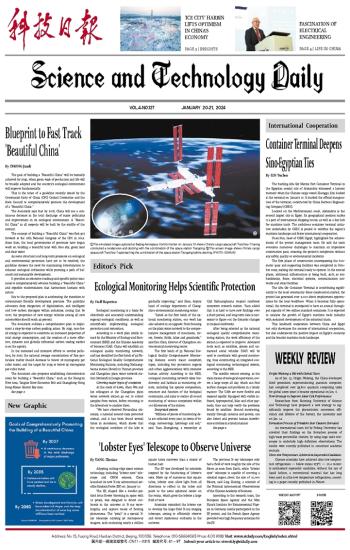
 Fascination of Electrical Engineering
Fascination of Electrical Engineering 'Ice City' Harbin Lifts Optimism in China's Economy
'Ice City' Harbin Lifts Optimism in China's Economy Blueprint to Fast Track 'Beautiful China'
Blueprint to Fast Track 'Beautiful China' PHOTO NEWS
PHOTO NEWS Container Terminal Deepens Sino-Egyptian Ties
Container Terminal Deepens Sino-Egyptian Ties Ecological Monitoring Helps Scientific Protection
Ecological Monitoring Helps Scientific Protection WEEKLY REVIEW
WEEKLY REVIEW New Graphic
New Graphic 'Lobster Eyes' Telescope to Observe Universe
'Lobster Eyes' Telescope to Observe Universe
Adopting cutting-edge space science technology, including "lobster eyes" telescope and CMOS sensors, China launched its new X-ray astronomical satellite Einstein Probe (EP) on January 10.
The EP, shaped like a double-pistiled lotus flower blooming in space with 12 petals, was designed to detect outbursts in the universe at X-ray wavelengths, and capture traces of fleeting phenomena. The "petal" is a special X-ray telescope carrying 36 microporous imagers, each containing nearly a million square holes narrower than a strand of human hair.
The EP was developed by scientists inspired by the functioning of lobster's eyes. Made up of numerous tiny square tubes, lobster eyes allow light from all directions to reflect in the tubes and point to the same spherical center on the retina, which gives the lobster a large field of view.
Scientists mimicked the lobster eye to develop the large-field X-ray imaging telescope, aiming to efficiently observe and detect mysterious outbursts in the universe.
The previous X-ray telescopes only had a field of view roughly the size of the Moon as seen from Earth, while "lobster eyes" telescope is capable of covering a celestial region about the size of 10,000 Moons, said Ling Zhixing, a scientist of the National Astronomical Observatories of the Chinese Academy of Sciences.
According to the research team, the European Space Agency and the Max Planck Institute for Extraterrestrial Physics in Germany jointly participated in the EP project, and the French Space Agency provided very high frequency antennas for the EP.

 Next
Next



